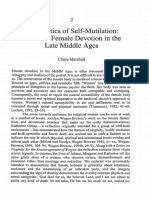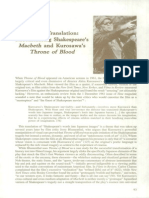An Anthropological Critique of The Films of Robert Gardner
An Anthropological Critique of The Films of Robert Gardner
Uploaded by
Carlos ReynaCopyright:
Available Formats
An Anthropological Critique of The Films of Robert Gardner
An Anthropological Critique of The Films of Robert Gardner
Uploaded by
Carlos ReynaOriginal Title
Copyright
Available Formats
Share this document
Did you find this document useful?
Is this content inappropriate?
Copyright:
Available Formats
An Anthropological Critique of The Films of Robert Gardner
An Anthropological Critique of The Films of Robert Gardner
Uploaded by
Carlos ReynaCopyright:
Available Formats
AN ANTHROPOLOGICAL CRITIQUE OF THE FILMS OF ROBERT GARDNER [1] by JAY RUBY Journal of Film and Video 43.
4 (Winter 1991).
Note - original pagination has been retained for citations purposes. Copyright 1991 by J. Ruby
Robert Gardner is well-known for his deeply evocative films on exotic cultures. His film on ritual warfare, Dead Birds (shot among the Dani tribes of New Guinea) created a huge controversy.... Equally controversial is the style of his films which don't pretend for a moment to be scientific but instead place before us the images of his dreams (or even nightmares) of what he has witnessed. In the North American, Anglo-Saxon rush towards pragmatic cinema, he has stayed aloof, to one side, continuing his highly professional work. (Young 23) Introduction To begin-a moral tale or, more correctly, a fantasy in which an anthropological cinema exists, a cinema of not about anthropology designed by anthropologists to communicate anthropological insights about the human condition. It is a well articulated genre distinct from the conceptual limitations of realist documentary. It employs conventions and techniques from the whole of cinema-fiction, documentary, animation, and so forth. A multitude of film styles vie for prominence, equal to the number of theoretical positions found in the field. There are general audience films produced for television as well as highly sophisticated works for professional audiences. The producers are professional anthropologists who use the medium to convey the results of their anthropological studies and ethnological knowledge. Universities regularly teach the theory, practice, and criticism of anthropological communication-verbal, written, and pictorial-enabling scholars to select the most appropriate mode of communication in which to publish their work. The fantasy has not been realized nor is there any reason to believe that it ever will. Instead, ethnographic film appears trapped in a perpetual state of flux. Unable to maintain a stable power base, it occupies a position marginal to mainstream academic social science and to the commercial worlds of independent documentary film and educational television. In North America, its most enduring feature is the fact that teachers use films in the classroom. While the anthropological use of pictorial media may be as old as the technology itself, the possibility that an ethnography could be presented as a film remains a confusing idea. In the popular mind, an ethnographic film is a documentary about any "exotic" people regardless of the training of the maker. International festivals supposedly
devoted to anthropological films often have organizing committees with no anthropologists who select films for special recognition produced by documentarians with no apparent knowledge or even regard for anthropology. Some are overtly hostile to the idea of social science, regarding it as politically incorrect-a remnant of a racist, colonial past. In addition, many anthropologists seem content with films made by people with little or no anthropological knowledge merely because the films appear to be politically correct or somehow artistically satisfying. Ethnographic film has always been a field dominated by documentary filmmakers who fancy themselves amateur anthropologists. Beginning with the work of Robert J. Flaherty, many of the films called ethnographic were made by people without training in or knowledge about anthropology. These films may become useful because teachers of anthropology contextualize them for their students, but then almost any film, documentary or fiction, can be useful to teach with if it is placed in the right context. As an academic anthropologist interested in seeing ethnographic film become a part of the anthropological mainstream, I believe the chief criteria that should be employed in critiquing a film designated as "ethnographic" are those of anthropology and not the aesthetics of film. Is the film the result of ethnographic research? Is the person who conducted the field work in a position of authority in the production so that decisions as to the shape of the film are determined by the results of the research and not the current fad in film form? Does the film successfully address itself to anthropological concerns or not? Whether or not a film is an artistic achievement is as irrelevant to social scientific goals as whether or not anthropological writings are literary achievements. [2] Having briefly stated my point of view, I will now critique the cinema of Robert Gardner as a means of discussing some of the impediments to the development of an anthropological cinema. Robert Gardner made a major contribution to ethnographic film during the 1950s and 1960s. However, since the production of Dead Birds, his films have drifted away from the main stream of anthropology. This movement is the result of two factors: (1) Gardner's dependence on an outmoded and inadequate theoretical perspective; and (2) his failure to utilize anthropological knowledge derived from ethnographic field work to organize his films. In addition. I find the politics and morality of Gardner's "art" to be problematic. Gardner's Legacy to Ethnographic Film Robert Gardner's involvement with ethnographic film began at a time when few considered film a serious medium for anthropologists. Since 1956 he has been the director of Harvard University's Film Study Center, the earliest North American focus for ethnographic film. During the first decade of the center's activities, Gardner assisted in the completion of John Marshall's The Hunters, produced Dead Birds, taught production courses, provided completion assistance for other filmmakers, and conceived a scheme for filming disappearing cultures, an idea that dominated his work ever since. With Karl Heider and Asen Balikci, he founded Program in Ethnographic Film, the first North American organization to deal with film and anthropology, and published "Films For Anthropology Teaching" to further the use of film in universities.
The Film Study Center was established to house the "Bushman" (San) footage and to assist John Marshall in the editing of "between twenty and twenty-five distributable films" (Gardner, "Anthropology" 350). Conflicts caused Gardner and Marshall to part ways after the completion of just one film, The Hunters, in 1957. Gardner continued to pursue the Center's stated mandate in New Guinea, Africa, and India. Gardner's ideas about filming other cultures were first articulated in 1957. Cinematic recordings of human life are unchanging documents providing detailed and focused information on the behavioral characteristics of man.... The most significant advantages of cinematic documentation are that evidence provided is available to the view of many individuals both immediately and for a period of time. ("Anthropology" 345-6) In addition, he posited that evidence collected with a cine-camera is "of a direct and unambiguous kind, being reality instantaneously captured and suffering no distortion due to faults of sight, memory, and semantic interpretation" (346). Once the center gathered pictorial documentation, films should be made . . . after it [the center] has had the opportunity to document various wide contexts of human life, it can proceed to make from such documentation visual expressions of the meaningful parts of it to be seen and shared by as many people as can be reached. (349) Ultimately the justification for this work went beyond anthropological goals to the humanistic assumption that "creating a careful and sensitive visual account of an unknown society was ample justification in itself'' (Gardner and Heider xi). Gardner hoped to produce filmed samples from cultures representing the basic ecological varieties of human experience; this was not dissimilar to G.P. Murdock's Human Relations Area File schema. Once gathered the center would have the definitive film archive on the varieties of human experience. In describing the development of the idea for Dead Birds, Gardner articulated his plan. With a film on a primitive hunting society already available (The Hunters), it seemed appropriate to think in terms of one about an agricultural group. Then at least two of the three basic ecological patterns of human society would have been documented. Materials I gathered on three pastoral societies in Ethiopia will be released as three full length films early in 1970. With their appearance the third basic pattern of human adaptation will be represented. ("Chronicles" 25) [3] The Harvard-Peabody Expedition to New Guinea-Dead Birds In 1961 Gardner organized the Harvard-Peabody Expedition among the horticultural Dani of the highlands of New Guinea. He spent eight months (February to August 1961) doing ethnography and filming in collaboration with anthropologists Jan Broekhuyse and Karl Heider for what became his most widely acclaimed film, Dead Birds. The expedition was organized like a nineteenth-century natural historical/scientific expedition with a number of people each conducting their own research. One is reminded of the Karl Bodmer/Maximillian expedition to North America in the 1830s and the Lawrence Marshall expeditions to the Kalahari Desert in the 1950s that
produced The Hunters. While the expedition was primarily motivated by Gardner's notion of salvage ethnography, it was also fueled by an interest in ritual warfare. Hence it was partially in the spirit of conservators of a passing age that we planned the Harvard-Peabody New Guinea Expedition.... It was my hope to make a study of a society still practicing what in anthropological annals is known as "ritual warfare" that turned our attention to Melanesia.... The overall aim of the expedition was to make a comprehensive study of a single community of Neolithic warrior farmers. We intended to document verbally and visually the whole social and cultural fabric of this community. We were interested in its natural history and were equipped to scrutinize it from the stand point of behavioral scientists, naturalists, photographers and filmmakers. Our specific goals included an ecologically oriented account by Peter Mattheisson . . .; my feature-length motion picture . . .; an anthropological monograph dealing with the whole culture . . . by Karl Heider; a second anthropological monograph by Jan Broekhuyse . . .; and a book of photographs. (Gardner and Heider xii-xv) To this ambitious list, Karl Heider's 1972 ethnographic film companion should be added, along with the work of other members of the team, which included Michael Rockefeller as sound recordist and still photographer, Time-Life photographer Eliot Elisofon, and Christopher Versteegh as botanist. According to Heider, Gardner conceived the expedition to produce materials from different points of view, and give somewhat different pictures of the Dugum Dani . . . which would have important implications for anthropological methodology quite apart from its value as an intensive, multidimensional portrayal of a single group of Papuans. (Heider, "The Dani" 2-3) Unfortunately this most satisfying aspect of the expedition never received the attention it deserves. No one, neither a member of the original expedition nor any scholar since, has critically examined or compared the written and pictorial materials produced by the expedition. Critique of Dead Birds Dead Birds, one of the most popular ethnographic films in the history of the genre, was produced in the tradition of Robert Flaherty's Nanook of the North and John Marshall's The Hunters. Like The Hunters, its flaws and shortcomings are quite visible to us now given the vantage point of time. For some, the problems make the film almost worthless. "My judgment is that Dead Birds has been colored by so many subtle fictional pretensions and artistic ornamentations that it has surrendered most of its usefulness as a socially scientific document" (Mischler 669). It seems rather futile, though, to ask a film made in 1964 to assume the standards of the 1990s. The film's inadequacies are more profitably understood as the results of the filmmaker's choices rather than the limitations of the technology or the fact that the film followed the dominant conventions of the time. Dead Birds employs the conventions of commercial feature fiction to achieve an illusion of reality. It is the "story" of Wejak and Pua; that is, like Nanook or the quartet
of San hunters in The Hunters, the life of the culture is unfolded through the lives of individuals. Dead Birds has a story line contrived so that the principals just happen to be present at events the filmmaker wishes to reveal. Thus warfare and events associated with it are revealed through Wejak's participation. At times the device becomes less than transparent, for example, when Pua just happens to visit Wejak when he is completing the weaving of a cowry shell band. It has been my experience as someone who uses the film in classroom teaching that students often become distanced from the artificiality of the narrative structure and begin to disbelieve the entire film. Dead Birds is constructed so as to create the illusion that a narratively compelling and comprehensive story is evolving, naturally and chronologically. Even if one argues that cinema requires such artifices, the fact remains that the illusion is false. We never see an actual battle but rather a composite one constructed from the footage of several battles"The major battle sequence in Dead Birds is put together from shots of different battles at different locations'' (Heider, Ethnographic Film 67). Similarly, the sound track is constructed to make you believe you are hearing synchronized sound when in fact, "All the sound in Dead Birds is postsynchronized . . ." (70). Weyak's "voice" is a creation in a sound studio. Whether or not one finds such an approach to anthropological cinema offensive depends on whether one believes that films should be made out of what is filmable, constructed out of what is deemed necessary in order to have the film's thesis look convincing. Gardner believed that the footage he had of any one battle was inadequate to make the statement he wished to make about Dani warfare. So he constructed a ''cinebattle'' containing all the elements he considered important. The notion of typicality which underlies the choice to construct a "cine-battle" is but one example of the nineteenth-century scientific ideology found in Gardner's work. Like Marshall in The Hunters, Gardner created and narrated interior monologues for some of the principals. We are told Weyak's thoughts when he looks at a sunset. At another place in the film we are told that a warrior recently wounded in battle is recalling how the enemy would not take any chances in battles fought in the past. The scene of the warrior "recalling'' is followed by a flashback of a battle scene. These fiction tactics provide continuity between sequences and act as a lead-in to a sequence that would otherwise lack a smooth transition. I would assume that most anthropologists then, as now, would object to attributing thoughts to the subjects of their studies. To argue that the nature of the film requires that certain liberties be taken with knowledge is to suggest a serious lack of fit between film and anthropology. From the opening narration of the fable about the race to determine the fate of humankind to the narrator's closing thoughts about our mortality, audiences are made aware that they are viewing a dramatically structured film designed to be a moral tale. I seized the opportunity of speaking to certain fundamental issues in human life. The Dani were then less important to me than those issues.... My responsibility was as much to my own situation as a thinking person as to the Dani as also thinking people. I never thought this reflective or value-oriented approach was inconsistent either with my training as a social scientist or my goals as the author of a film.... The film attempts to say something about how we all, as humans, meet our animal fate. (Gardner qtd. in Heider, Dani 6)
A humanist desire to provide a meditation about morality clearly took precedence over the need to articulate the details of Dani culture or to adhere to what was actually knowable about the people. Gardner is telling us that he is more of an artist-humanist than an anthropologist. While a humanistic approach to anthropology is certainly commendable and having aesthetic aspirations that causes one to become craft conscious about the medium employed is praiseworthy, humanism, or the creation of art, are not adequate as theoretical justifications for doing anthropology. There are some fundamental methodological and moral questions raised by Dead Birds that continue to be raised by Gardner's later work. It concerns the question of consent, and the knowledge the subjects should have about a filmmaker's intention. Gardner believes that his work would have been hampered if the subjects understood what was going on. "My job was made easier because no one knew what I was doing" (Gardner qtd. in Heider, Dani 8). As far as my film was concerned, one essential advantage lay in the fact that the Dugum Dani did not know what a camera was. I decided to protect this innocence by keeping all photographs and magazines hidden.... I wanted above all to photograph authentic Dani behavior. (Gardner, "Chronicles" 30; emphasis added) Given the agonizing debate over informed consent and the rights of subjects, which has raged during the past 20 years among North American anthropologists and other researchers who employ human subjects, Gardner's assumption that only naive subjects are worthwhile filming is at best out of touch with contemporary ethical thinking and at worst reflects a naive assumption about what one can and should film (see Gross, Katz, and Ruby). While it can be argued that in 1961 these issues were not in the forefront of the field, they certainly are now and Gardner appears to be as unconcerned with them when discussing Forest of Bliss as he was in New Guinea (Larson). The idea that it is necessary to conceal your intentions from people in order to get useful footage stands in direct opposition to French anthropologist/cineaste Jean Rouch's notion of a shared anthropology, a concept he explored in a number of films prior to Gardner's work with the Dani (for example, in The Human Pyramid [1958] and Les Maitres Fous [1957]). Rouch has said that the idea of a shared or collaborative anthropology was derived from Flaherty in the 1920s when Flaherty showed Nanook the footage he shot in order to obtain his cooperation and collaboration (Ruby "Reexamination"). Gardner rejected the idea of a shared anthropology where the participants in a film become collaborators with the director. He chose instead to approach the Dani as naive subjects when alternatives were available. [4] He apparently believed that the only "authentic" behavior worth filming was behavior "unsullied" by Western influences, performed by people unaware of what was being done or of the long-term implications of being filmed. One could argue that Dead Birds is a product of its time and that in 1961 there were no other models for making documentary or ethnographic films. [5] Gardner was simply doing the best he could. The argument is not adequate, though. At the time Gardner was planning Dead Birds, a number of documentary and ethnographic filmmakers were voicing their discontent with the limitations imposed upon them by their equipment and the dominant tradition of dramatic documentaries that imitated Hollywood features. During 1960 and 1961 many experiments in syncsound location shooting were being
made-for example, by Michael Brault in Canada, and by Robert Drew, Richard Leacock, and D.A. Pennebaker in the United States, who produced Primary in 1960. When Jean Rouch and Edgar Morin released Chronicle of a Summer in 1961, it was regarded as a revolution in film. In other words, direct cinema and cinema verite were being invented at the same time Robert Gardner chose to employ a traditional and, for some filmmakers, an outmoded approach to filming and documentary dramatic structure. The "look" of Dead Birds is no accident of technology or of the time in which it was produced. It is the product of a certain approach to film and culture. While his style has evolved somewhat, for example, more observational footage and sync-sound interviews in Rivers of Sand, in all of his subsequent work, Gardner has adhered to the theoretical stance which motivated Dead Birds. Robert Gardner as Anthropologist and Artist All of Gardner's productions, from Dead Birds to Ika Hands, are understandable as enactments of sentiments first expressed in 1957-the assumption that salvage ethnographic film projects that produce visual records of the customs of disappearing cultures provide an invaluable resource for future generations as well as an opportunity to produce films for the public. It has been his stated desire to systematically record as many of the basic culture types as possible. The ideological underpinnings of his approach are found in nineteenth-century science, which sought to inductively describe phenomenon, then produce a taxonomy. Once "all the data" were collected a scientist could begin to make analyses and eventually draw conclusions. Natural history expeditions like the Harvard-Peabody Expedition to New Guinea are expressions of these ideas. In anthropology, the paradigm manifested itself in the distinction between descriptive ethnography and ethnological analysis. To collect useable data, ethnographers sought out the least "disturbed" remnants of exotic cultures or, lacking any "survivals," they reconstructed the ethnographic present through the memories of the oldest members of the group. Only "authentic" culture was deemed appropriate to record. When photographed or filmed, natives were asked to remove any physical evidence of their actual circumstances. that is, Western clothing and ornaments, and "perform" authentic reproductions of their former lives. [6] Altar of Fire (1976), a film Gardner was invited to direct by University of California scholar, Fritz Staal, provides us with one example of the inadequacy of Gardner's paradigm. The film is a 45-minute condensation of what the promotional brochure from the distribution company modestly calls "the world's oldest surviving ceremony.'' In the brochure Staal unselfconsciously explains that in order to "preserve" a ritual which had not been performed for some time, the filmmakers had to pay for the cost of the ceremony. Given the somewhat unusual nature of this "media event," as Edmund Carpenter called it on the sound track, a number of spectators gathered. Staal and Gardner had to go to great pains to exclude the unreasonable "natives" who thought they might have some right to participate in their ceremony! In spite of their efforts, Some film footage was spoiled or its use made impossible by these fully clothed people (that is, visitors from the outside who came to watch the ceremony), who contrasted
sadly with the Nambudiris (Brahmin priests) in their white loincloths, themselves disfigured only by an occasional wristwatch. (Steal; emphasis added) Fortunately the "purity" of the media-generated ceremony was preserved. As Robert A. Paul suggested, The only way this film could have worked, in both an ethical and a "scientific" way, would have been for the makers to have been flexible and honest enough to record the media event which they themselves set in motion. Instead, they pretend to give us an authentic glimpse into ancient Vedic times, rendered hollow and ethically repugnant through the patronizing, rigid, antiquarian, and neocolonialist attitudes it reveals. (Review 199) [7] Staal's response to Paul's review suggests that he failed to understand the criticism. [8] He states that anyone reading the film's study guide would have known the circumstances of the filming and those wishing to know something about the socioeconomic context can consult his written work ("Comment" 346-47). The problem is that unless stated within the film, the information is non-existent for most audiences. Moreover, Staal and Gardner failed to see the implication of omitting these aspects of the event from the film. In Paul's response to Staal, he writes that The filmmaker has certain responsibilities to the subjects of the film, to other local people whose lives are affected by the presence of a foreign film crew, to the potential audience, and to the scholarly community. It was, and is, my opinion that Altar of Fire does not meet those responsibilities, sensitivity, or awareness of the issues. With respect to the audience, lay and scholarly, it seems to me that the film is not sufficiently forthcoming about some of the circumstances surrounding the making of the film, knowledge of which would seriously affect what the viewer might suppose he were watching. (''Reply" 348) A proper critique of the intellectual, moral, and political implications of "salvaging authentic cultures" lies outside the limits of this essay. Suffice it to say that the paradigm as expressed by Staal, and I would argue most of Gardner's films, systematically avoids the economic and political conditions of the people studied and filmed and is therefore easily criticized as romantic and supportive of political and economic neo-colonialism and other forms of oppression. If one is able to deny the existence of political and economic inequality and oppression by causing people to perform some imagined version of their past lives, then the problems and whatever responsibility we may have for them literally disappear before our eyes! While Gardner is certainly neither the author of this concept nor the only contemporary practitioner, his prominence makes his adherence to these ideas a stumbling block to the development of an anthropological cinema. Our fondness for capturing on film or in print the varieties of human experience, in all their pristine and unsullied glory, has had a long history within anthropology, as well as within Western culture as a whole. [9] While it is still possible to locate some proponents of this approach in the Instint fur den Wissenschaftlichen Film, North American anthropology has largely replaced this paradigm. [10], It is more commonly assumed that all behavior is authentic, Westernized or not, and that description unmotivated by research questions and not grounded in an articulated theory is virtually useless.[11] From the perspective of many
current theoretical positions within anthropology (for example, feminist, Marxist, Geertzian interpretive, and so forth), Robert Gardner's stated anthropological justification for his films is at best an anachronism that should find little support from professional anthropologists. Yet one seldom reads in the reviews of his films in journals like the American Anthropologist any discussion of the adequacy of his theoretical approach. Instead reviewers uncritically accept the films as anthropologically useful and applaud the artistry of the films, a matter to be discussed below [12] While it could be argued that Gardner is entitled to his theoretical perspective, no matter how out of touch it is with contemporary thinking, I would assume that most anthropologists would agree that there are certain minimal methodological standards to be met if one is to call a film ethnographic. Gardner himself has acknowledged that ''for a film to be ethnographic, an ethnographer must make it, or at least be closely associated with its making" ("The Ethnographic Film'' 66). Unfortunately, an examination of the field work associated with Gardner's films often makes the designations anthropological or ethnographic questionable. To my knowledge, Gardner has never learned the language of any of the people he filmed except for the Dani, nor has he stayed in the field in any of his filming expeditions long enough to do adequate ethnography. [13] While he is sometimes credited with being an anthropologist and conducting ethnographic studies, there is little evidence to support those assumptions. [14] Consequently, the only possibility his films have to express anthropological knowledge based upon ethnographic re search is through the anthropologists Gardner hires as subject area specialists. We must therefore examine Gardner's collaboration with anthropologists if we wish to critique the adequacy of his films as anthropology. Collaborations between filmmakers and anthropologists are often problematic. If a survey were taken, I think most anthropologists would say that their experiences with professional filmmakers have been somewhat less than satisfying. These collaborative efforts often result in acrimonious disputes over credits. This is a problematic area, but nonetheless it must be discussed. Some of Gardner's reputation appears to be built upon what might generously be called "confused credits." The role he played in The Hunters is uncertain, at least to me. The stylisic similarities between the narration in The Hunters and in Dead Birds suggest that Gardner had an important voice in both. On the other hand, John Marshall's name does not even appear in the 1957 article Gardner wrote discussing the activities of the Film Study Center. If you did not know otherwise, the article would lead you to believe that Robert Gardner made The Hunters by himself. His involvement with Kal Mueller's Land Divers of Borneo and Jorge Preloran's Imaginero are equally problematic. While some ethnographic filmmakers like Karl Heider have found Gardner to be someone who generously gives his time and expertise, others have privately expressed dissatisfaction with the credit Gardner has received for their films. The Nuer is the most clear-cut example. Gardner produced it as part of the pastoral nomad project that included Rivers of Sand. Certainly raising the funds, conceiving the idea, and so forth are important but if there are authors of the film, they are Hillary Harris and George Breidenbech. Yet in two editions, the Pennsylvania State University audiovisual catalog has contained the following listing: ''The Nuer, a film by Robert Gardner and Hillary Harris,'' and retrospectives of Gardner's work usually include this film.
The credits for Rivers of Sand, Gardner's 1975 film about East African pastoralists, read, "Ethnographic advice and translations: Ivo Strecker, Jean Lydall (Strecker) and Eike Berinas" (Bender 196). In a 1988 article Strecker makes it clear that when he joined Gardner in the field, one season of filming had already been realized without any assistance from an ethnographic authority. The casualness with which this supposedly anthropological work was undertaken, at least as Strecker reports it, is truly appalling. The artistic vision of Gardner as auteur dominated the project with little competent ethnographic assistance. I was also frustrated because I remained barred from the process of conceptualizing the film as a whole. In 1971, Bob and I both knew very little about Hamar culture.... and I found it extremely difficult to make any generalizations. I sensed that Bob was planning a grand new explanatory film about the Hamar. (Strecker 372) Lionel Bender, reviewer for the American Anthropologist, has argued that "this is a great film.... For the present, Rivers of Sand is our best available source on the Hamer [sic] of Southern Ethiopia. Fortunately. it is a magnificent source" (Bender 197). Lydall and Strecker answered Bender, labeling the film "an ethnographic farce" and pointing out that they were denied participation in "the decisive stages of filming" (Lydall and Strecker 945). The film is not a reliable source of information on the Hamar but it is a source of study of ". . . the social milieu of filmmakers and anthropologists who use ethnography to indulge in prejudiced visions that have little to do with the people under 'study' '' (Lydell and Strecker 945). [15] The narrative spine of Rivers of Sand is an interview with a Hamar woman, Omalleidna, lamenting the role of women in her society. The theme of physical abuse dominates the interview and some of the intercut scenes. According to Strecker, ". . . instead of recognizing that Omalleidna's account was a conventionalized story of womanhood, Gardner treated it as though it were a factual commentary.... Gardner, in his flat undialectical view of social life, did not recognize this irony'' (Strecker 945). In other words, Gardner failed to realize what is an anthropological cliche-what people say about themselves is not the truth but data. "Interestingly, other critics have rarely mentioned this point [that is, the distortion of Hamar life in the film]. Even David MacDougall accepts the film at face value and writes: 'Rivers of Sand examines a socially regulated sexual exploitation through the toll it takes upon individuals' " (Strecker 373). In Rivers of Sand, Gardner employs slow-motion shots of women running up to men, thrusting their breasts toward their "oppressors," and apparently taunting the men to beat them. Omalleidna claims she and all women in her group are oppressed, yet they appear to provoke the beatings. What are we as the audience to make of this conflict between what she says and what Gardner shows us? The relationship between men and women in Hamar appears more complex than Omalleidna's theory. Bob, however, preferred to edit his material to fit her theory and his own ideas about male domination, rather than to explore actual relationships between men and women.... That the whipping was ritualized and initiated by the girls themselves is not made clear in the film. (Strecker 373) We have a clear choice with this film. We can accept either the "artistic vision" of someone who spent a few months in the field and who presents no evidence of
competence in the field language. or the opinion of an ethnographer who knows the culture, the language, and has produced several publications and films based on his experience with the Hamar. Two of Gardner's films list no credit for anthropologist/translator/ethnographic advisorDeep Hearts and Ika Hands. [16] 1 can discover little about the circumstances of filming Deep Hearts, but logically there are two possibilities: either the film was made without benefit of any anthropologically competent personnel, or those who participated did not wish to be associated with the film. In either case, the enthusiastic review given Deep Hearts by Michael Lieber is yet another example of an anthropologist being content with the artistic vision of a filmmaker rather than questioning whether the film has any ethnographic research to support it. As in Dead Birds, his major work, Gardner exhibits a strongly felt humanism, viewing cultural events and styles as illustrations of the human condition. This view of things is almost conveyed by his narration and only weakly supported by his imagery, which is specific and parochial. But, criticisms aside, Gardner must be thanked for bringing back such spectacular images, so lovingly filmed. (Lieber 225) Forest of Bliss, a film about Benares, India, is quite another matter. Unlike Rivers of Sand, Deep Hearts, or even Ika Hands, the anthropologist/co-producer, Akos Ostor, claims that the film is based on six months of ethnographic field research and has recently come to its defense. In Great Britain, the film won a prize as the best ethnographic film of the past two years. On the other hand, Gardner has made it quite clear that he views it as "a personal film, not an ethnographic one'' (Larson 88).[17] In two recent reviews, the writers conclude that the film cannot be fruitfully considered as anthropology (Parry; Moore). Since Gardner apparently agrees, I would prefer to use the film as a means of exploring Gardner's work as art. Forest of Bliss has been characterized as a haunting portrait of the city of death. Moore, along with a number of other people, has characterized it as "an aesthetic masterpiece" (Moore 1).1 disagree. I found it to be a jumble of incomprehensible vignettes that apparently are to be savored for their formal content and the juxtaposition of the images and sequences. The film, like Louis Malle's Phantom India, falsely mystifies. I don't know the language of the people in the film. I rarely can figure out what they are doing, or if I can, the significance of the action is lost to me. I attribute meaning that stands a good chance of being accidentally ethnocentric and incorrect because I cannot infer anything about the maker's intention. As Parry has pointed out, the film easily misleads all but the most expert viewers. Since the maker has indicated that what is said is not important enough to translate and the vignettes of behavior are not consequential enough to present in such a way as to make them understandable, I am left with a kind of pure formalism. While some people find this approach satisfying, I do not, at least with this film. I do not wish my position to be misunderstood. I am not an opponent of formalist cinema. On the contrary, a film like Edin Velez's Meta-Maya 11, for example, is an extremely satisfying work in this mode. I am arguing that Forest of Bliss, in addition to being useless as ethnography, is a failure as film art. Gardner mistakes ignorance for mystery. India is mysterious only to those too lazy to learn something about it.
I do not completely agree with Parry and Moore's position that subtitling and spoken narration must be present in a film dealing with an experience exotic for most viewers. Since the invention of sound, film has relied far too much on words to explain. The possibility of visual explanations is still intriguing. I do not condemn this film because Gardner tried to convey meaning visually. I criticize him for failing to succeed in this task. A defense informally offered by some anthropologists for Robert Gardner's recent films. like Forest of Bliss, may be summarized as follows: "Well, they may not be so great as ethnography but they are wonderful art. Because they are so moving, say important things about the human condition, have such beauty, we will forgive their anthropological shortcomings and accept them anyway." This justification is based upon the false assumption that all film is art, and consequently ethnographic film has to somehow compromise its social science in order to succeed. [18] The ethics and politics of Gardner's art as manifested in Forest of Bliss require further discussion. Gardner used the lives of people of Benares to make his art, aesthetic objects that form the raw material for the creative process. He did so with no apparent moral qualms. "I had no ethical embarrassment in making the films. I had my own feelings about what was going on ... and they shaped the film and the shots. I wasn't trying to suppress my feelings. I needed them" (qtd. in Larson 98). Part of the appeal of this film to a Western audience is the exotic quality of Indian life. There is a history to the idea of the "mysterious" East, perhaps best explored in Edward Said's book, Orientalism. Tom Waugh has suggested that Forest of Bliss was simply one more Mondo Cane India, an ethnographic variant of the recent glut of Indian imagery in the Western media marketplace. Our reliance on colonialized images of India such as these, in the past has greatly hampered our knowledge of, and our solidarity with, this vital and changing society. (13) Were Gardner to choose images from his own class and culture, North American Yankee Brahmin, a "tribe" as exotic to some of us as the subject of this film, the moral and political implications would be very different. The basis of Gardner's art is to be found in nineteenth-century Romanticism and his behavior as film artist is justified by the notion of "artistic license.'' Briefly stated, it is the assumption that because artists create beauty essential for society, they are allowed to behave differently from other people. Artists must be true to their vision no matter what. For many of us that notion of art is morally and politically out of step with the times. Artists are a part of society and must answer for their behavior just as other people do. Making art out of the lives of people who are politically and economically disadvantaged, disenfranchised, oppressed, is increasingly difficult to justify, particularly when the artist comes from the most privileged class of the most powerful nation of the world. But even if one believes that artists do have the right and can treat their colleagues and the people they film any way they wish, how can anthropologists justify these notions? Since the Vietnam War, North American anthropologists have been made acutely aware of the need to examine the political and moral implications of their work and the
complexities involved in using the Other as the subject of their research. Why should they embrace the "art" of someone who is so apparently uninterested in those questions? A corollary to the assumption that artists have a certain moral license is the idea that films that are sensitive empathetic portraits of a people do not require the services of an anthropologist to make them into ethnographic films. I presume that those who take this position argue that because "artistic vision" is as important as ''ethnographically derived knowledge and insight," we should accept these films as if they were anthropology. The logic of this argument carries us to the absurd position of having to accept virtually the whole of literature and film as anthropology and thus eradicating whatever uniqueness anthropology has as a means of generating statements about the human condition. If we endorse Gardner's art, why not everyone else's? There are literally hundreds of sensitively made poetic documentaries about the human condition. Why not characterize all of them as anthropological? Conclusions Robert Gardner was a seminal figure in ethnographic film during the 1950s and 1960s. However. his public remarks, writings, and his films since Dead Birds do not reflect any apparent interest in nor any knowledge about the issues which have occupied anthropology since the 1970s. Gardner has remained faithful to the outmoded and inadequate notion that anthropology's primary task is to salvage the last remnants of "authentic primitive" culture. He seems unresponsive to or unaware of the ethical and political implications of these ideas and behavior. Rather than regard his films as anthropology, I believe it is more productive to critique them as the work of a Romantic artist who believes that the exotic Other provides him with a unique chance to explore his personal responses to humanistic questions such as death (Forest of Bliss), the role of women (Rivers of Sand). and gender identity (Deep Hearts). Because we are easily seduced by what some regard as Gardner's ''artistic vision,'' some members of the anthropological community continue to appreciate Gardner's films as ethnographically significant. They do so, I might add, with the active encouragement of Gardner. [19] Notes [1] This essay began as a polemical response to articles by Moore and Parry and Robert Gardner's response in the Society for Visual Anthropology Newsletter 4.2. A preliminary statement was first published in Society for Visual Anthropology Newsletter 5.1. An earlier version of this paper appeared in 1989 in German as "Robert Gardner und der anthropologische Film," in Ritual con Leben und Tod: Robert Gardner and seine Filme. R. Kapfer. W. Petermann und R. Thoms, Hrsg. Munchen: Trickster Verlag. Initially, I wrote out of frustration with the uncritical acceptance of some films by some anthropologists. What I have to say has already been said privately by a number of my colleagues. I think it is time to deal with the issues in a public manner. The criticisms are not meant as a personal attack but rather as the beginning of a long overdue selfcritical process. The criticisms leveled at Gardner apply to most of the "leading lights" in ethnographic film. [2] I have discussed this approach to anthropological cinema in a number of articles beginning in 1975 with "Is an Ethnographic Film a Filmic Ethnography?"
[3] While it is not the purpose of this essay to trace the origins of Gardner's ideas about film and anthropology, it would be wrong to leave readers with the impression that he was solely responsible for them. Margaret Mead comes to mind as the most obvious intellectual ancestor to Gardner. [4] In a 1958 article on a UNESCO conference Gardner discusses Rouch's films and therefore provides evidence that he knew about Rouch's ideas. [5] See Heider's Ethnographic Film for this argument. [6] For a further explication of these ideas. cf. Ruby, 'Franz Boas," on Boas's use of the camera. [7 ]Richard Schechner has also made a most revealing analysis of the paradigm Staal and Gardner employed in making this film. [8] I am assuming that Staal speaks for Gardner and as co-producers of the film they share attitudes about the issues raised here. Certainly Gardner has not distanced himself from Staal's published views of the film. [9] A number of people, from Stanley Diamond to Edward Said' have explored our construction of the primitive and the exotic Other. [10] See Visual Anthropology 1.3 (1988) for descriptions of the German approach to ethnographic film. [11] Among the many anthropologists who have made this argument the work of Clifford Geertz is perhaps the most widely read. [12] It could be argued that Gardner wrote the article cited as explicating his ideas in 1957 and his position has evolved over the past 30 years. However, nothing in his films, writings, or public statements suggests a significant change. and Ika Hands (1988), his latest film, is about yet another "cultural survival." [13] 1 am assuming here that there is common agreement that ethnography can only be accomplished through a long-term intensive period of participant-observation governed by an articulated research problem. [14] Heider (Films) credits Gardner as being ''anthropologist" for Rivers of Sand but is unable to support this contention with any evidence. [15 ] In the 10 years since Lydell and Strecker wrote their rebuttal to Bender's review, Strecker's opinion of the film has changed very little. ''In Rivers of Sand. Hamar life is not allowed, as it were, to reconstitute itself on the screen. The constant cuts and counter-positioning of short sequences never allow an authentic view of Hamar life to emerge but lead to a complete distortion of time, space, and action as they are experienced by the Hamar" (373). [16 ] The credits for Deep Hearts come from the American Anthropologist review; for Ika Hands, I consulted the 1988 Festival dei Popoli catalog. Serious ethical questions
have been raised about the filming of Ika Hands. Unfortunately, I was unable to obtain sufficient documentation about some of the allegations to include them in this paper. [17] The source of Gardner's quotations is unattributed in Larson's article. [18] The notion that all film is art is as silly as the idea that all writing is literature. For a more prolonged argument against this cliche see Sol Worth's classic essay, ''Film as Non-Art." [19] There appears to be some uncertainty on the part of Gardner as to whether or not he regards himself as an ethnographic filmmaker. When he showed Rivers of Sand at the Robert Flaherty Film Seminar in 1977, he was uninterested in discussing the film or any of his work as anthropology. His most recent essay, "The Fiction of Non-Fiction Film," published in 1986, suggests a total lack of interest in ethnographic film. Yet he has actively cooperated with the British Royal Anthropological Institute's Ethnographic Film Festival and recently reviewed two of Geddes's films for the American Anthropologist ( 1987).
Works Cited Bender, Lionel. Review of Rivers of Sand. American Anthropologist 79 (1977): 196-97. Gardner, Robert. ''Anthropology and Film." Daedulus 86 (1957): 344-52. . "Chronicles of the Human Experience: Dead Birds." Film Comment 2.1 (1969): 25-34. . "The Ethnographic Film." Films in Review 9 (1958): 65-73. . "The Fiction of Non-Fiction Film." Cilect Review (1986): 2324. -. Reviews of The Soul of the Rice and Brides of the Gods. American Anthropologist 89 (1987): 265-67. Gardner, Robert, and Karl G. Heider. Gardens of War: Life and Death in the New Guinea Stone Age. New York: Random House, 1968. Gross, Larry, John Katz, and Jay Ruby, eds. Image Ethics: The Moral Rights of Subjects in Photographs, Film and Television. New York: Oxford UP, 1988. Heider, Karl. The Dani of West Irian: An Ethnographic Companion to the Film Dead Birds. New York: Warner Modular Publication, 1972. . Ethnographic Film. Austin: U of Texas P. 1976. -. Films for Anthropological Teaching. Washington D.C.: American Anthropological Association, 1983.
Larson, Heidi. "Gardner's Forest Fires: Hindu Bliss." Anthropology and Humanism Quarterly 12.3-4 (1987): 9798. Lieber, Michael. ''Review of Deep Hearts." American Anthropologist 82 (1980): 22425. Lydall, Jean, and Ivo Strecker. "A Critique of Lionel Bender's Review of Rivers of Sand." American Anthropologist 80 (1978): 945-46. MacDougall, David. "Ethnographic Film: Failure and Promise." Annual Review of Anthropology (1978): 405-25. Mischler, Craig. "Narrativity and Metaphor in Ethnographic Film: A Critique of Robert Gardner's Dead Birds." American Anthropologist 87 (1985): 668-72. Moore, Alexander. "The Limitations of Imagist Documentary: A Review of Robert Gardner's Forest of Bliss." Society for Visual Anthropology Newsletter 4.2(1988): 1-3. Ostor, Akos. "Is That What Forest of Bliss is All About?" Society for Visual Anthropology Newsletter 5.1 (1989): 4-8. Parry, Jonathan P. "Comment on Robert Gardner's Forest of Bliss." Society for Visual Anthropology Newsletter 4.2 (1988): 4-7. Paul, Robert. Review of Altar of Fire. American Anthropologist 80 (1978): 197-99. . "Reply to Staal's Comments." American Anthropologist 81 (1979): 347-48. Ruby, Jay. "The Emperor and His Clothes." Society for Visual Anthropology Newsletter 5.1 (1989): 9-11. . "Franz Boas and Early Camera Study of Behavior." Kinesis Reports 3.1 (1980): 6-11. -. "Is an Ethnographic Film a Filmic Ethnography?" Studies In The Anthropology of Visual Communication 2.2 (1975): 104-11. . "A Re-examination of the Early Career of Robert J. Flaherty." Quarterly Review of Film Studies 5.4 (1980): 431-57. Said, Edward. Orientalism. New York: Pantheon, 1978. Schechner, Richard. "Collective Reflexivity: Restoration of Behavior." A Crack in the Mirror: Reflexive Perspectives in Anthropology. Ed. Jay Ruby. Philadelphia: U of Pennsylvania P. 1982. 39-82. Staal, Fritz. Altar of Fire Promotional Brochure. U of California Extension Media Center, 1976. . "Comment: Altar of Fire." American Anthropologist 81 (1979): 346-47.
Strecker, Ivo. "Filming Among the Hamar." Visual Anthropology 1.4 (1988): 369-78. Waugh, Thomas. " Independent Documentary in India: A Preliminary Report. " Society for Visual Anthropology Newsletter 4.2 (1988): 13- 14. Worth, Sol. "Film as Non-Art: An Approach to the Study of Film." The American Scholar 35 (1966): 322-34. Young, Colin. Intro. to Gardner, "The Fiction." 23.
Appendix
The films of Robert Gardner cited in the article (All films produced by the Film Study Center, Harvard University) Dead Birds (1964) 83 min. Robert Gardner (director, camera, script, narration), Karl Heider and Jan Broekhuyse (anthropologists), Jarius Lincoln and Joyce Chopra (editors). Ritual warfare among the Dani of New Guinea. Rivers of Sand (1975) 85 min. Robert Gardner (director, script, camera, narrator, and sound), Ivo Strecker and Jean Lydall (anthropologists), Stewart Gardner and Michael Chalufour (editors). The role of women in Hamar society, Ethiopia. Altar of Fire (1976) 58 min. Fritz Staal (producer), Robert Gardner (director), Gardner and Staal (script), Daniel Ingalls (narrator), Gardner, Kevin Burker, Ravi Varma, Kunju Vasudevan, Sarwesh Kumar (camera), Michael Chalufour (sound), Staal, Gardner, and Edmund Carpenter (editors). A performance of the Agnicayana, a Vedic ritual of sacrifice. Deep Hearts (1981) 58 min. Robert Gardner (director, script, narrator), Robert Fulton and Gardner (camera and editors). A male "beauty contest" among the Bororo Fulani of Niger. Forest of Bliss ( 1986) 90 min. Robert Gardner (director, camera, sound), Akos Oster (anthropologist), Ned Johnson and Michael Chalufour (editors). A portrait of Benares, India, city of death. Ika Hands (1988) 60 min. Robert Gardner (director, script, camera, sound), Gardner and Gerardo Reichel-Dolmatoff (narrators), Robert Fulton and Michael Chalufour (editors). Indian families survive in the bitter cold of Colombia's Andes.
You might also like
- Marshall, Claire - The Politics of Self-Mutilation Forms of Female Devotion in The Late Middle AgesDocument11 pagesMarshall, Claire - The Politics of Self-Mutilation Forms of Female Devotion in The Late Middle AgesPabloGarciaNo ratings yet
- No Man An Island - The Cinema of Hou Hsiao-Hsien PDFDocument267 pagesNo Man An Island - The Cinema of Hou Hsiao-Hsien PDFanon_465141044No ratings yet
- Einstein On The Beach: The Primacy of MetaphorDocument13 pagesEinstein On The Beach: The Primacy of MetaphormentalpapyrusNo ratings yet
- Breath, Eyes, MemoryDocument1 pageBreath, Eyes, Memoryroneisha samuelsNo ratings yet
- Pull My DaisyDocument22 pagesPull My DaisyMaria CastellviNo ratings yet
- Bhabha Transmision Barbarica de La Cultura MemoriaDocument14 pagesBhabha Transmision Barbarica de La Cultura Memoriainsular8177No ratings yet
- Films of Memory MacdougallDocument9 pagesFilms of Memory MacdougallCatarina MouraoNo ratings yet
- Marsden, Jill - Review of Inner TouchDocument11 pagesMarsden, Jill - Review of Inner TouchCostin ElaNo ratings yet
- (Colleen McDannell) Catholics in The Movies (PDF) (ZZZZZ) PDFDocument377 pages(Colleen McDannell) Catholics in The Movies (PDF) (ZZZZZ) PDFWesleysleite100% (1)
- Kabbalah Explains MusicDocument1 pageKabbalah Explains MusicAlexandros KapataisNo ratings yet
- Ethnographic Film: Failure and PromiseDocument22 pagesEthnographic Film: Failure and PromiseChristina AushanaNo ratings yet
- The Institutionalization of Educational Cinema: North America and Europe in the 1910s and 1920sFrom EverandThe Institutionalization of Educational Cinema: North America and Europe in the 1910s and 1920sNo ratings yet
- Mathias Cinema-A Medium of The SublimeDocument33 pagesMathias Cinema-A Medium of The SublimeAmalia WojciechowskiNo ratings yet
- Futile Pleasures: Early Modern Literature and the Limits of UtilityFrom EverandFutile Pleasures: Early Modern Literature and the Limits of UtilityNo ratings yet
- Anna Grimshaw - The Ethnographers Eye - Ways of Seeing in Modern Anthropology PDFDocument121 pagesAnna Grimshaw - The Ethnographers Eye - Ways of Seeing in Modern Anthropology PDFLe Luatique100% (1)
- Jacques Demy and His Other WorldDocument6 pagesJacques Demy and His Other WorldEmma Schwarz100% (1)
- Film Socialisme Liberating Words From TH PDFDocument32 pagesFilm Socialisme Liberating Words From TH PDFMáster Guion CineNo ratings yet
- Narratology - A Guide To The Theory of NarrativeDocument81 pagesNarratology - A Guide To The Theory of NarrativeSujatha Menon100% (1)
- Trauma Hiroshima Mon Amour - ArticuloDocument15 pagesTrauma Hiroshima Mon Amour - ArticuloJose Luis FernandezNo ratings yet
- We Have Never Been Modern ReviewsDocument2 pagesWe Have Never Been Modern ReviewsErica Pelta FeldmanNo ratings yet
- Sex in The Empire - Book Review PDFDocument4 pagesSex in The Empire - Book Review PDFPaul ChanNo ratings yet
- Relaying Cinema in Midcentury Iran: Material Cultures in TransitFrom EverandRelaying Cinema in Midcentury Iran: Material Cultures in TransitNo ratings yet
- (Routledge Studies in Social and Political Thought) Arpad Szakolczai - Comedy and The Public Sphere - The Rebirth of Theatre As Comedy and The Genealogy of The Modern Public Arena-Routledge (2015)Document475 pages(Routledge Studies in Social and Political Thought) Arpad Szakolczai - Comedy and The Public Sphere - The Rebirth of Theatre As Comedy and The Genealogy of The Modern Public Arena-Routledge (2015)poepoeNo ratings yet
- Students' Presentations: Research Topics, Resources and FindingsDocument4 pagesStudents' Presentations: Research Topics, Resources and FindingspedrocorgaNo ratings yet
- The Films of Stan Brakhage in the American Tradition of Ezra Pound, Gertrude Stein and Charles OlsonFrom EverandThe Films of Stan Brakhage in the American Tradition of Ezra Pound, Gertrude Stein and Charles OlsonRating: 5 out of 5 stars5/5 (2)
- Full Text of - Simone de Beauvoir - Brigitte Bardot and The Lolita SyndromeDocument24 pagesFull Text of - Simone de Beauvoir - Brigitte Bardot and The Lolita SyndromeJoão Pedro BohrerNo ratings yet
- The Adventure of The RealDocument4 pagesThe Adventure of The Realkellp22No ratings yet
- Suzuki Throne of Blood PDFDocument12 pagesSuzuki Throne of Blood PDFjlnsaNo ratings yet
- Review Book-Complexity The Emerging Science at The Edge of Order and ChaosDocument6 pagesReview Book-Complexity The Emerging Science at The Edge of Order and ChaosEdgar CuellarNo ratings yet
- Home and Migration: A Bibliography: Homing Working Paper No. 2 - 2018Document41 pagesHome and Migration: A Bibliography: Homing Working Paper No. 2 - 2018Francisca Pérez PallaresNo ratings yet
- Parker Throne of Blood PDFDocument19 pagesParker Throne of Blood PDFjlnsa100% (1)
- There Is No Sex Life in The GraveDocument6 pagesThere Is No Sex Life in The GraveGabriel Laguna Mariscal100% (1)
- Movies and Conduct Blumer Herbert PDFDocument284 pagesMovies and Conduct Blumer Herbert PDFJosé Luis González CallejasNo ratings yet
- Rohmer LiterarinessDocument117 pagesRohmer Literarinessn v100% (1)
- Barry Posen - Command of The CommonsDocument43 pagesBarry Posen - Command of The CommonsJuanBorrellNo ratings yet
- Silent Features: The Development of Silent Feature Films 1914 - 1934From EverandSilent Features: The Development of Silent Feature Films 1914 - 1934Prof. Steve NealeNo ratings yet
- Aristotle 3Document7 pagesAristotle 3Saedur RahmanNo ratings yet
- Cannibal ManifestoDocument11 pagesCannibal ManifestoMaurits-Kirstin VBDonkerNo ratings yet
- Wilhelm Meister's Apprenticeship & Wilhelm Meister's Journeyman YearsFrom EverandWilhelm Meister's Apprenticeship & Wilhelm Meister's Journeyman YearsNo ratings yet
- Lysistrata: "Love is simply the name for the desire and the pursuit of the whole"From EverandLysistrata: "Love is simply the name for the desire and the pursuit of the whole"Rating: 4 out of 5 stars4/5 (514)
- Eurykleia and Odysseus' Scar: Odyssey 19.393-466Document3 pagesEurykleia and Odysseus' Scar: Odyssey 19.393-466aristarchos76No ratings yet
- The Enigmatic Coat of Fathers : An Engineer's Son's Emotional JournalFrom EverandThe Enigmatic Coat of Fathers : An Engineer's Son's Emotional JournalRating: 5 out of 5 stars5/5 (1)
- American Academy of Arts & Sciences, The MIT Press DaedalusDocument17 pagesAmerican Academy of Arts & Sciences, The MIT Press Daedalusdanaethom100% (1)
- Annie Hall: Transposition of Narrative StructureDocument10 pagesAnnie Hall: Transposition of Narrative StructureMichael Jones100% (1)
- The Theory of Will in Classical AntiquityFrom EverandThe Theory of Will in Classical AntiquityRating: 2.5 out of 5 stars2.5/5 (2)
- Antigone: Guide To Sophocles'Document3 pagesAntigone: Guide To Sophocles'ratso1No ratings yet
- Educ Act 1982 SummaryDocument7 pagesEduc Act 1982 SummaryMarilyn Magbanua90% (10)
- Blank LevelDocument4 pagesBlank LevelNavin KumarNo ratings yet
- CPC Action PlanDocument2 pagesCPC Action Planphilip gapacan100% (18)
- Body Ritual Among The NaciremaDocument6 pagesBody Ritual Among The Naciremaiulya16s6366No ratings yet
- The Art of FlirtingDocument2 pagesThe Art of FlirtingNabeel TirmaziNo ratings yet
- BibDocument2 pagesBibjasonxddNo ratings yet
- The Hindi-Urdu Controvercy of The North-Western ProvincesDocument11 pagesThe Hindi-Urdu Controvercy of The North-Western ProvincesRahulNo ratings yet
- A Review of The Buying Behaviour of The Millennials in IndiaDocument6 pagesA Review of The Buying Behaviour of The Millennials in IndiaPoonam KilaniyaNo ratings yet
- Source: Jose Rizal: Gregorio Zaide and Sonia ZaideDocument58 pagesSource: Jose Rizal: Gregorio Zaide and Sonia ZaideMichael VallespinNo ratings yet
- Lesson Plan Shampooing and Conditioning - 0Document8 pagesLesson Plan Shampooing and Conditioning - 0Mclin Jhon Marave Mabalot100% (2)
- Blind Spot: Book ReviewDocument1 pageBlind Spot: Book ReviewVani SaraswathiNo ratings yet
- Kemahiran Mendengar Dan BertuturDocument30 pagesKemahiran Mendengar Dan BertuturDe SyuhadaNo ratings yet
- Philo Written Recitation LcupDocument2 pagesPhilo Written Recitation LcupjhonaNo ratings yet
- A-Z Pronunciation GuideDocument32 pagesA-Z Pronunciation GuideDesperado Manogaran M75% (4)
- Organization Studies 1994 Alvesson 535 63Document30 pagesOrganization Studies 1994 Alvesson 535 63Bujorianu SimonaNo ratings yet
- Summarize Written TextDocument8 pagesSummarize Written TextTEJASHREE BEDEKARNo ratings yet
- Fi3 FinalDocument8 pagesFi3 Finalapi-457245797No ratings yet
- The Deaf and Language: Sign, Oral, Written: PsycholinguisticsDocument7 pagesThe Deaf and Language: Sign, Oral, Written: PsycholinguisticsAgriawan100% (1)
- Difference Between Book and Thesis: What Is A Book?Document5 pagesDifference Between Book and Thesis: What Is A Book?Tahirullah KhanNo ratings yet
- The Objects of LexicologyDocument4 pagesThe Objects of LexicologyAizhanar ZhamigatovaNo ratings yet
- Bachelor of Arts With Education (Baed)Document8 pagesBachelor of Arts With Education (Baed)lameck paulNo ratings yet
- Pusong MalabonDocument9 pagesPusong MalabonMichael TanchongcoNo ratings yet
- Okvirni Plan I Program Za Dip in 4Document4 pagesOkvirni Plan I Program Za Dip in 4Bedrudin NurikicNo ratings yet
- Science Olympiad FlyerDocument2 pagesScience Olympiad FlyerIra RozenNo ratings yet
- P3000 English BookDocument225 pagesP3000 English BookSeppForcher2No ratings yet
- English Teaching Professional 64 Sept 2009Document72 pagesEnglish Teaching Professional 64 Sept 2009anitamarquesNo ratings yet
- Brenda - Laurel - Utopian Entrepreneur PDFDocument121 pagesBrenda - Laurel - Utopian Entrepreneur PDFJosé Antonio Sánchez MelchorNo ratings yet
- Yugoslavia-The Ideology and The State, Their Rise and Their DemiseDocument8 pagesYugoslavia-The Ideology and The State, Their Rise and Their DemiseAnonymous mQhML438t5No ratings yet

























































































